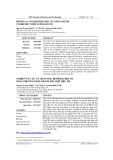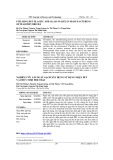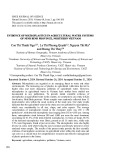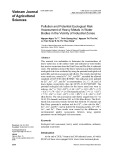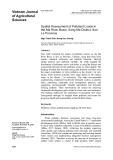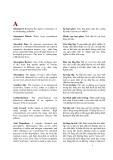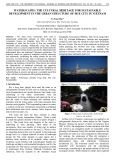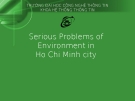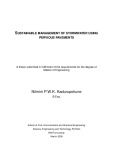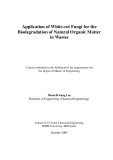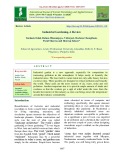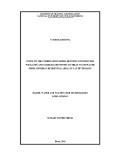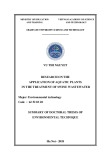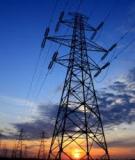
Water pollution
-
The removal of organic dyes from wastewater is essential to protect the ecosystem and human health. This study evaluated the ability of the ozone system combined with ultrasound to remove organic pigment disperse red 152 (DR152).
 8p
8p  viengfa
viengfa
 28-10-2024
28-10-2024
 4
4
 2
2
 Download
Download
-
This study also contributes to reducing environmental pollution caused by plastic and glass waste as well as current construction brick production methods. The results show that the bulk density, compressive strength, and bending strength of brick samples made from PET plastic and glass waste are higher than those of burnt clay brick samples, while water absorption is much smaller than that of burnt clay brick samples.
 8p
8p  viengfa
viengfa
 28-10-2024
28-10-2024
 2
2
 1
1
 Download
Download
-
The aim of this is study to analyze and compare the amount of microplastics in the surface water and water column samples at Han River estuary (Da Nang) in the rainy season 2023. Sixteen water samples (eight water column samples and eight surface water samples) were collected and analyzed to determine the quantity, shape, color, size, and polymer forms of microplastics.
 9p
9p  vimitsuki
vimitsuki
 30-03-2025
30-03-2025
 0
0
 0
0
 Download
Download
-
Water quality plays an immensely significant role in safeguarding the health of humans and other species on the planet. Polluted water sources can contain harmful substances such as heavy metals, pesticides, bacteria, and viruses, which can pose threats to human health and other organisms. Water quality is also a crucial factor in protecting the environment and sustaining the ecosystems of freshwater and marine environments. Polluted water sources can impact the lives of aquatic animals and plants, causing harm and endangering biodiversity by disrupting the food chain.
 11p
11p  viuzumaki
viuzumaki
 28-03-2025
28-03-2025
 4
4
 0
0
 Download
Download
-
Microplastics are regarded as an emerging threat to water and other environments. The increasing use of plastics in agricultural cultivation has led to higher risks and more dangerous pollution of agricultural water. However, microplastics in agricultural water in Vietnam have neither been studied nor documented in any publication.
 13p
13p  viaburame
viaburame
 14-03-2025
14-03-2025
 8
8
 1
1
 Download
Download
-
This research was undertaken to determine the concentrations of heavy metal ions in the surface water and sediment in water bodies that receive wastewater from the Dinh Tram and Pho Noi A industrial zones. The pollution status of the heavy metal ions and their potential ecological risks were evaluated by using the potential ecological risk index (RI) and risk assessment code (RAC).
 11p
11p  vibecca
vibecca
 01-10-2024
01-10-2024
 8
8
 2
2
 Download
Download
-
This study evaluated the impact of pollution sources on the Ma River Basin in Son La Province, Vietnam, using data from local reports, statistical yearbooks, and scholarly literature. The study recommended implementing centralized wastewater treatment systems in priority areas, promoting sustainable land management practices, and supporting environmentally friendly agricultural and livestock farming methods.
 14p
14p  tuetuebinhan000
tuetuebinhan000
 23-01-2025
23-01-2025
 3
3
 2
2
 Download
Download
-
A Abatement: Reducing the degree or intensity of, or eliminating, pollution. Abatement Debris: Waste from remediation activities. Absorbed Dose: In exposure assessment, the amount of a substance that penetrates an exposed organism's absorption barriers (e.g.,, skin, lung tissue, gastrointestinal tract) through physical or biological processes. The term is synonymous with internal dose. Absorption Barrier: Any of the exchange sites of the body that permit uptake of various substances at different rates (e.g., skin, lung tissue, and gastrointestinal-tract wall).
 217p
217p  holigon10
holigon10
 15-06-2012
15-06-2012
 475
475
 150
150
 Download
Download
-
In recent decades, Hue’s waterscape has undergone considerable change due to urbanization, environmental pollution, flooding, and disruption of water flow. These factors have altered the characteristics of traditional waterscape and negatively affected the previous concept of water system.
 6p
6p  vibenya
vibenya
 31-12-2024
31-12-2024
 11
11
 2
2
 Download
Download
-
Saigon river is also polluted by industrial and agricultural waste water from small-sized enterprises along the river which is to 65.000 cubic meters a day. Residential waste water another pollution factor. Everyday, 74.800 cubic meters of waste water in dumped into the river from residential in localities, with over 90% of the waste coming from Hồ Chí Minh city.
 62p
62p  tet0202
tet0202
 19-02-2013
19-02-2013
 45
45
 5
5
 Download
Download
-
The research reported herein has demonstrated that pervious pavements can be introduced as a sustainable stormwater management initiative and as a key Water Sensitive Urban Design feature to deliver numerous benefits to the environment. The outcomes from the study will be useful in designing environmentally friendly car parks, pedestrian paths, light traffic drive ways, sporting grounds and public areas in the future.
 244p
244p  runthenight05
runthenight05
 01-03-2023
01-03-2023
 16
16
 3
3
 Download
Download
-
The research herein builds on the work of Rojek (2003) and further investigates the bioremediation of NOM wastes. The aim of this research was to evaluate the effectiveness of selected white-rot fungi and yeast for the biodegradative removal of concentrated NOM from solution. The effectiveness of the white-rot fungus P. chrysosporium ATCC 34541 for the biological degradation of different batches of MIEXTM NOM concentrate and the effects of different characteristics of the NOM on the process and thus the resistance of the NOM to microbial removal were investigated.
 131p
131p  runthenight05
runthenight05
 01-03-2023
01-03-2023
 13
13
 3
3
 Download
Download
-
Objectives of the study: Assessing the situation of catfish farming in some areas of the Mekong Delta as a basis for proposing measures to manage waste from catfish ponds; the survey and analysis in catfish ponds to assess the composition and characteristics; assessing the pollutants load of waste water from catfish ponds; assessing the possibility of wastewater treatment from catfish ponds and benefits of environmental when using wastewater for irrigating paddy fields.
 26p
26p  beloveinhouse10
beloveinhouse10
 28-11-2021
28-11-2021
 27
27
 3
3
 Download
Download
-
objectives: To identify the state of heavy metal pollution in water and food in two coastal communes of Thuy nguyen District, Haiphong city in 2017- 2018. To describe the pattern of disease and the risk due to exposure to heavy metal contamination among community residents in the study area.
 27p
27p  extraenglish
extraenglish
 24-05-2021
24-05-2021
 27
27
 4
4
 Download
Download
-
Industrial garden is a new approach, especially for competition in increasing pollution in the atmosphere. It helps easily to beautify the industrial areas. The lawn laid in vacant lands not only adds beauty but also cut down dust. These gardens are designed to reduce pollution and beautify the world. These units are the most sources of air, water, noise and soil pollution.
 7p
7p  chauchaungayxua11
chauchaungayxua11
 23-03-2021
23-03-2021
 6
6
 2
2
 Download
Download
-
Evaluate domestic wastewater removal of the models combining constructed wetlands with stabilisation ponds. Determining the decomposition coefficients of some typical pollutants in domestic wastewater of constructed wetlands and stabilisation ponds with the natural conditions of Cau river basin. Proposing the technology models combining constructed wetlands with stabilisation ponds to treat domestic wastewater from suburban residential areas of Cau River basin met the standard of Column A of QCVN 14:2008/BTNMT.
 28p
28p  kequaidan7
kequaidan7
 01-09-2020
01-09-2020
 24
24
 3
3
 Download
Download
-
The objective of research is to build CNST using TVTS to treat pig waste water after microbiological treatment, to minimize environmental pollution. Technology is feasible when applied in practice.
 27p
27p  xacxuoc4321
xacxuoc4321
 11-07-2019
11-07-2019
 39
39
 3
3
 Download
Download
-
Wastewater Management is one of the most concerns in any urban area. An efficient management contributes to the wealth of a community, never the less a poor management leads to unpredictable hazards related to health, environmental pollution, etc. In developed countries, the issues of water and sanitation are solved, floodings are well controlled.
 115p
115p  change15
change15
 08-07-2016
08-07-2016
 34
34
 3
3
 Download
Download
-
Teach children to learn English is quite hard work and complex by young are not really conscious of learning as adults and most are very giddy. For children focused on lessons, teachers need teaching combined with vivid visuals, invite you to consult the lesson English 6 "Unit 11 - Our greener world" for further reference in the process of teaching English children.
 16p
16p  dungvyqt2
dungvyqt2
 29-11-2015
29-11-2015
 274
274
 13
13
 Download
Download
-
The rapid economic growth in Vietnam has resulted in an increasing demand for electricity. This in turn translates to a higher rate of coal resource extraction and consequent rise in pollution of water and land resources. This study estimated the environmental costs associated with the electricity demand requirements of the coal electricity sector, as a component of the long-run marginal opportunity cost (LR-MOC) of electricity production.
 0p
0p  hailedangbs
hailedangbs
 02-05-2013
02-05-2013
 102
102
 25
25
 Download
Download
CHỦ ĐỀ BẠN MUỐN TÌM








